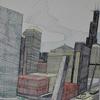New York's New Museum to Expand With Rem Koolhaas-Designed Building
- NEW YORK, New York
- /
- June 27, 2019
The New Museum announced plans for its second building, designed by OMA / Shohei Shigematsu and Rem Koolhaas in collaboration with Cooper Robertson. This will be OMA’s first public building in New York City.
The design complements and respects the integrity of the Museum’s SANAA-designed flagship building and replaces the Museum’s 50,000 square foot adjacent property at 231 Bowery, acquired in 2008. The new seven-story, 60,000 square foot building will include three floors of galleries, doubling the Museum’s exhibition space, along with additional space for the Museum’s many community and education programs, a permanent home for its cultural incubator NEW
INC, as well as increased public amenities and improved vertical circulation.
“Since the New Museum opened on the Bowery in December 2007, the Museum has become an international cultural destination welcoming millions of visitors,” said Lisa Phillips, Toby Devan Lewis Director.
James Keith Brown, President of the New Museum’s Board, also announced that the Museum has received a lead gift of $20M to its Capital Campaign, the largest gift in the institution’s history, from longtime trustee Toby Devan Lewis. The Museum will recognize Lewis’s leadership role at the New Museum by naming the OMA building in her honor.
To date the New Museum has raised $79 million towards its Capital Campaign goal of $89 million, with $63 million in construction costs. Groundbreaking for the new building is scheduled to start in 2020. The Museum will remain open and operational during most of the construction period, with a projected opening in 2022.
Adding a total of 10,096 sq. feet of exhibition space, the new galleries in the OMA building will connect with the SANAA building’s galleries on three levels (second, third, and fourth floors), with the ceiling heights aligning on each floor, doubling space for exhibitions and seamless horizontal connectivity between the buildings. The expanded spaces can be used singularly across the floor-plate to host larger exhibitions, or separately for diversity and curatorial freedom. The organization of new galleries and program spaces will support a stronger integration between exhibition programs and education, research, and residencies, that will help expand the Museum’s audiences.
















31100x100_c.jpg)